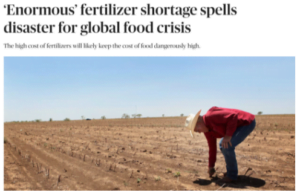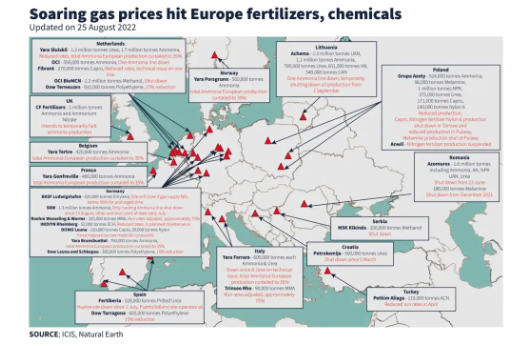Across the world fertilizer production is well below capacity endangering both agriculture and food production.
Majority of fertilizer plants remain offline in Europe — and no sign of relief for gas prices. The majority of nitrogen plants are down in Europe due to high gas costs. Buyers will import more urea and ammonia to tide over. How long though before we see bankruptcies in fertilizer plants in Europe? They can’t sustain in these conditions unless gas comes down.
The following shows the current fertilizer/chemical plant status in Europe:

According to Maximo Torero chief economist at the United Nations Food and Agriculture Organization (FAO) increased fertilizer prices could reduce global grain production by up to 40% in the coming planting season. Because prices are too high for some farmers ahead of the next planting season the global fertilizer shortage threatens to starve the planet.
Combine food supply chain disruptions caused by Ukraine’s war with crop failures caused by extreme weather and ramping up food production with reduced fertilizer next planting season via key exporting countries could be difficult. High fertilizer prices are expected to reduce global rice production. The grain feeds half of humanity and is critical to Asia’s and Sub-Saharan Africa’s political and economic stability. Supply disruptions could cause social unrest in those parts of the world.
The African Development Bank warned the continent lacks 2 million metric tons of fertilizer. Politico reported one UN official’s statement who spoke on the condition of anonymity: “We are really starting to yell from every tower that there’s a fertilizer crisis … and the fertilizer crisis is enormous.”[1]

Artificial fertilizers are made up of three main components: nitrogen phosphorus and potassium. Farmers use the finished product to increase crop yields; if prices remain high due to scarcity fewer fertilizers will be used and harvests will be smaller next season prolonging a multi-year food crisis that may only worsen.
The crop data that is also coming in via the media is so shocking — yields are so low — that losses can no longer be hidden. The next few posts will show how yields are suffering particularly in the United States the European Union and China. Also keep in mind that they are shifting the narrative to blame climate change as FOOD SHORTAGES will be used to justify zero-carbon CLIMATE totalitarianism.
BBC reported[2]that in what is likely the worst drought in 500 years two-thirds of Europe is under some kind of drought warning due to the ongoing heatwaves. According to the most recent Global Drought Observatory report[3] 47% of the continent is in “warning” conditions which means the soil has dried up. Another 17% is on alert which means that the vegetation “shows signs of stress.” According to the report the dry spell will reduce crop yields cause wildfires and could last for several months in some of Europe’s southern regions. EU harvest forecasts are down 16% for grain maize 15% for soybeans and 12% for sunflowers compared to the previous five-year average.
According to the report nearly all of Europe’s rivers have dried up to some extent. Aside from the obvious impact on boats dry rivers are also having an impact on the already-crisis-ridden energy sector. According to the report hydroelectric power has dropped by 20%.
According to the report the situation is deteriorating in Italy Spain Portugal France Germany the Netherlands Belgium Luxembourg Romania Hungary northern Serbia Ukraine Moldova Ireland and the United Kingdom.
[1]https://www.politico.eu/article/fertilizer-soil-ukraine-war-the-next-global-food-crisis/
[2]https://www.bbc.com/news/world-europe-62648912
[3]https://edo.jrc.ec.europa.eu/documents/news/GDO-EDODroughtNews202208_Europe.pdf

